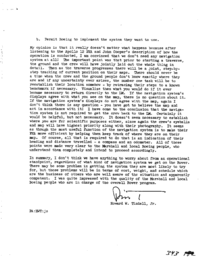See list attachedNovember 24, 196969-PA-T-147APA/Chief, Apollo Data Priority CoordinationRover Navigation
I poked my nose into the Rover Navigation System and so Dave Pendley invited me to a meeting at MSFC on November 21, 1969. The purpose of the meeting was to try and firm up the basic design of the Rover Navi- gation System with the Boeing people who are responsible for building it. It was strongly emphasized that time is very short to provide any system at all if they want to fly the Rover as currently scheduled. In fact, the Seattle Boeing people seemed very reluctant to consider any system other than the one they originally proposed because they insist there is not enough time. (Curiously enough it doesn't seem as though they really have a detailed design for even their proposed system. At least that is the impression I got from their responses to questions.)
It was interesting to observe that Marshall, the local Boeing management, and MSC people were completely in agreement on everything. What we all wanted to do was to simplify the system as much as possible. For example,
a. Eliminate the automatic sun-seeking azimuth alignment device.
b. Use the astronaut to reinitialize the system periodically through- out the traverse, thereby relaxing the accuracy requirement. They will want to check it periodically anyway.
c. Decouple the components such that failures in one part do not wipe out the entire system. Specifically, we would like some way of determining Rover heading and distance travelled – the most useful outputs – if the computer fails. This makes use of a directional gyro logical.
Boeing (Seattle) acted as if they never had heard of a directional gyro and almost certainly will come in with a negative response on their action item of looking into this simpler system. However, there were some guys from MSFC with heavy German accents who said they intended to check back into their labs to come up with some proposals. And the local Boeing guys will too. Then they are all supposed to get together in a week or two to decide what they are going to do. I would be amazed if Marshall is not put into a position where they must either:
a. Direct Boeing to implement the simpler system, which of course also gives Boeing a blank check for cost, schedules, etc.
b. Permit Boeing to implement the system they want to use.
My opinion is that it really doesn't matter what happens because after listening to the Apollo 12 EVA and John Cooper's description of how the operation is conducted, I am convinced that we don't need any navigation system at all! The important point was that prior to starting a traverse, the ground and the crew will have jointly laid out the whole thing in detail. Then as the traverse progresses there will be a joint, step-by- step tracking of current position on their maps. There should never be a time when the crew and the ground people don't know exactly where they are and if any uncertainty ever arises, the number one task will be to reestablish their location somehow – by retracing their steps to a known benchmark if necessary. Visualize then what you would do if it ever became necessary to return directly to the LM. If the navigation system's displays agree with what you see on the map, there is no question about it. If the navigation system's displays do not agree with the map, again I don't think there is any question – you have got to believe the map and act in accordance with it! I have come to the conclusion that the naviga- tion system is not required to get the crew back to the LM. Certainly it would be helpful, but not necessary. It doesn't seem necessary to establish where you are for scientific purposes either, since again the crew's eyeballs and map will have highest priority along with their photography. It seems as though the most useful function of the navigation system is to make their EVA more efficient by helping them keep track of where they are on their map. Of course, all that is required to do that is an indication of their heading and distance travelled – a compass and an odometer. All of these points were made very clear to the Marshall and local Boeing people, who understand them completely and intend to proceed accordingly.
In summary, I don't think we have anything to worry about from an operational standpoint, regardless of what kind of navigation system we get on the Rover. There may be some problem in getting the system they are most likely to try for, but those problems will be in terms of cost, weight, and schedule which are the business of others who are well aware of the situation and apparently competent. I was quite impressed with the quality of the Marshall and local Boeing people who are in charge of the overall Rover program.
- May 16, 1966 – Comments on the AS-207/208 Preliminary Spacecraft Reference Trajectory (4.1σ)
- Aug 01, 1968 – LM rendezvous radar is essential (3.7σ)


